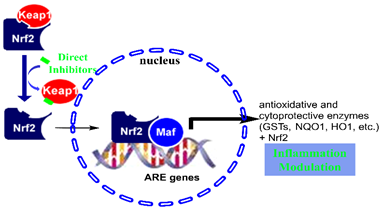
Novel Small Molecule Direct Inhibitors of Keap1-Nrf2 Protein-Protein Interaction
Invention Summary:
Nrf2 is a key transcription factor mediating anti-inflammatory and antioxidant responses in the body. Keap1 is a well-known repressor of Nrf2 that targets Nrf2 for its rapid proteasomal degradation. Dysfunctional Keap1-Nrf2 axis contributes to oxidative stress and inflammation underlying multiple disease conditions, including cancer, chronic obstructive pulmonary diseases (COPD), Alzheimer’s and Parkinson’s diseases, chronic kidney diseases (CKD) and diabetes. Therefore, Keap1-Nrf2 protein-protein interaction (PPI) is a promising therapeutic target for these diseases. However, earlier Keap1-Nrf2 modulators inhibit Keap1-Nrf2 PPI indirectly and irreversibly, which raises increasing concerns over their long-term toxicity in clinic. Therefore, there is an urgent need for the discovery of potent small molecule direct inhibitors of Keapl-Nrf2 PPI.
Rutgers scientists have invented novel small molecule direct inhibitors of Keap-Nrf2 PPI. These inhibitors feature unique scaffolds and high potency as non-electrophilic Nrf2 activators. In in vitro models, the inhibitors induce the expression of Nrf2-controlled genes and proteins and exhibit better efficiency than such
well-known Nrf2 activators as sulforaphane. Furthermore, pre-treatment with inhibitors protects cells against LPS-induced inflammatory responses, characterized by the altered cytokine levels. These new inhibitors show no obvious cytotoxicity in in vitro models. Due to their ability to inhibit Keap1-Nrf2 protein-protein interaction and activate Nrf2-mediated anti-inflammatory effect, these compounds can potentially be used to treat various oxidative stress-related diseases and conditions, including cancer, COPD, and neurological disorders.
Market Applications:
- Novel inhibitors for treatment for oxidative stress-related diseases
Advantages:
- Direct and non-electrophilic Nrf2 activator
- High potency and efficiency in inducing Nrf2 gene expression
- Low cytotoxicity
Intellectual Property & Development Status:
Patent pending. Available for licensing and/or research collaboration.